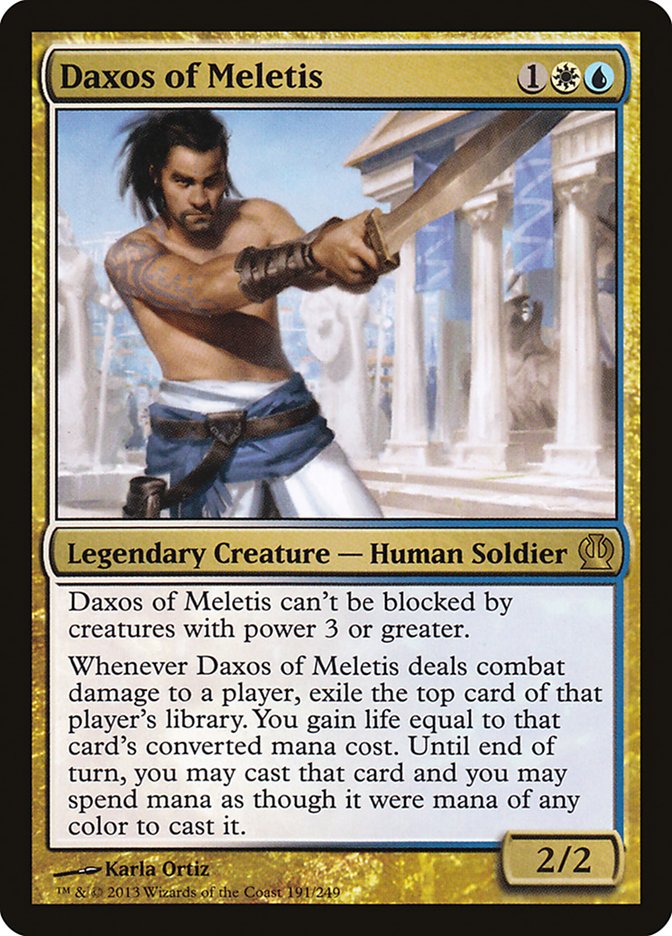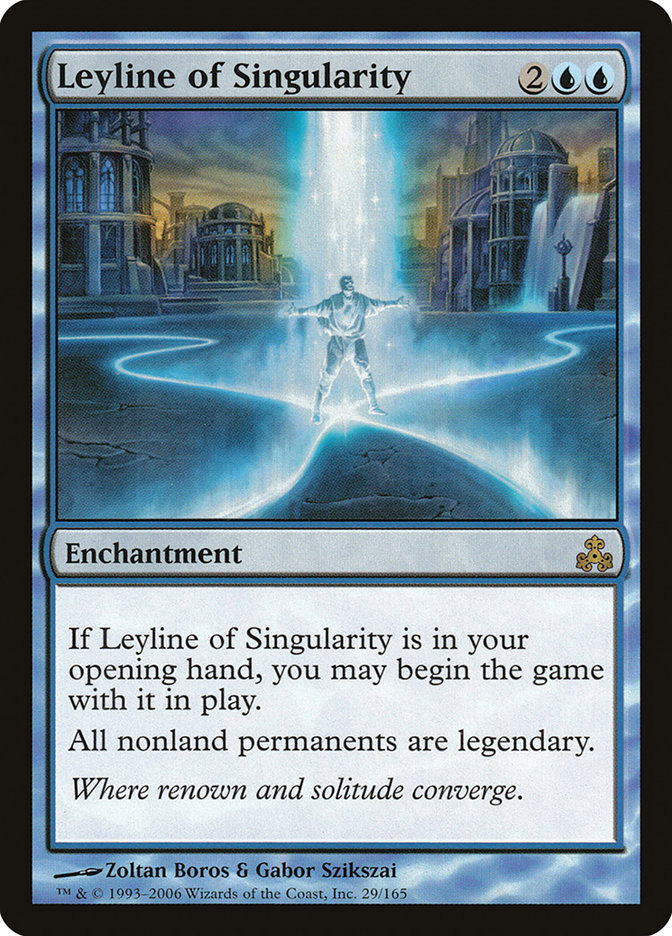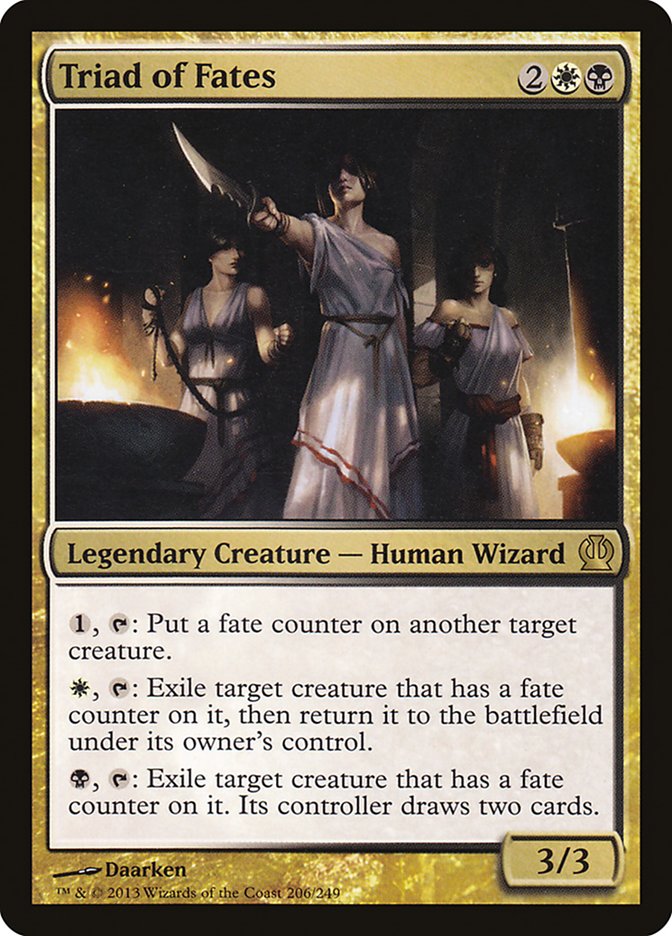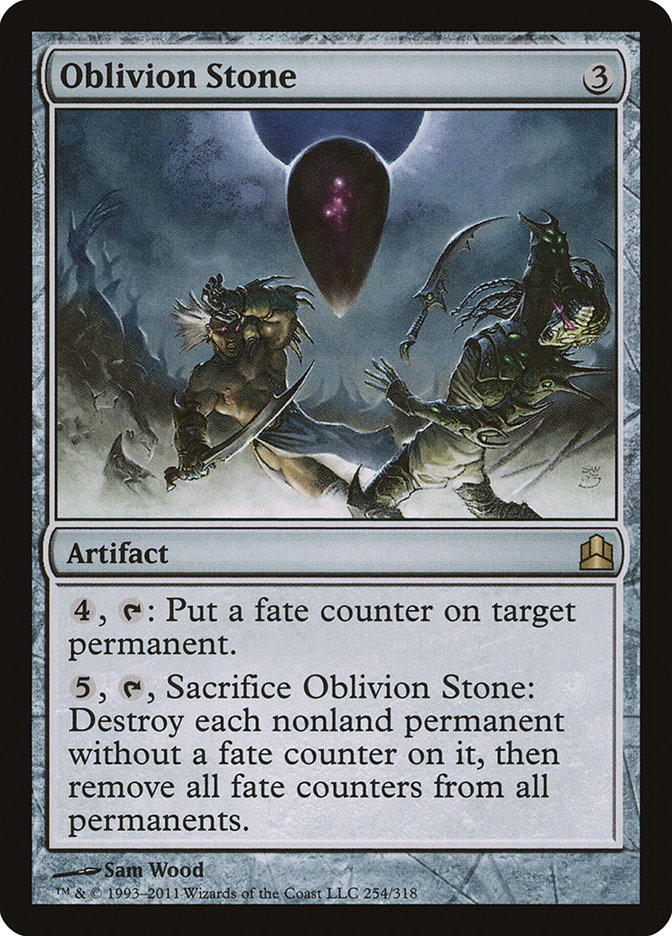The last few minutes of 2013 are ticking away, and it’s been a fun and exciting year in Magic! Lots of newness, lots of firsts, and lots of creative expressions in decks and strategies. As each year closes, it’s fun to look back at the beginning of it to see where the game was and how it’s changed since then.
If we look back a year ago from now, we can see the terror of Huntmaster of the Fells and greedy four-color control/midrange decks running through Standard. Mono-Red Aggro, which always seems to be a threat, was pounding decks that couldn’t resolve Supreme Verdict, and Reanimator strategies were popping up too. Standard was still settling down, and both Jund and Aristocrats decks were still a bit on the horizon from dominating the format completely. Now devotion, aggro, and U/W/x control decks are blossoming into regulars, and we’re all trying to figure out how to get around them.
My Magic life has changed a lot over the past few weeks; I’ve been invited to and made welcome in a new Commander playgroup, which I’m enjoying immensely. Commander can be such a fun format if you let it. Although some like to drain the fun out of the game in regards to the group dynamic, these folks all enjoy the wild plays and mighty swings typical of the big bruiser format, and I’m onboard. I’ve already brewed a couple new decks with Commander in mind, and I want to share them with you. If you’re just starting out, picking up one of the Commander 2013 preconstructed decks is a real bargain, but if you’re looking to make yours from scratch, I’ve got a couple ideas that will get you started. Strap yourselves in for a long one today!
Although there are over 500 legendary creatures to recruit from throughout the history of Magic, I’ll be pulling both generals from the three dozen Standard-legal legendary creatures. First, let’s take a look at one of my favorite cards from Theros.
Theros Favorite
There was a bit of chatter surrounding this Soldier once he was spoiled; although it was clear Geist of Saint Traft this was not, he intrigued a lot of people. Since then, of course, he’s vanished into obscurity, being a tough-to-cast Gray Ogre in colors not conducive to hard-hitting aggro. Although I’ve messed with him in Standard, I firmly believe his place is leading an army of 99.
So how do we make a fragile 2/2 a back-breaking commander? Good question; at that size, a brisk wind can kill him in Commander, so the key is connection and value generation. Because he can dodge most Commander-sized bruisers, this gives him an unexpected leg up, and the high cost of most Commander staples means that you’re gaining life and a powerful card when you hit. If we can make the most of those connections, we might be able to make Daxos work.
The ability to cast cards from the top is great, and the ability to cast those spells regardless of their mana cost (thankfully, the "as if it were mana of any color" lets us get around the pesky color-identity mana-production rule). To cast these spells, then, we just need mana. We don’t even need colors; we just need a lot of it. The mana "rocks" as they’re called (artifacts that produce one or more mana by themselves) provide the raw energy needed to turn even an early seven-drop into a reality. Power up!
Creatures (18)
- 1 Solemn Simulacrum
- 1 Platinum Angel
- 1 Hanna, Ship's Navigator
- 1 Trinket Mage
- 1 Brine Elemental
- 1 Guile
- 1 Etherium Sculptor
- 1 Filigree Angel
- 1 Thada Adel, Acquisitor
- 1 Sun Titan
- 1 Steel Hellkite
- 1 Shimmer Myr
- 1 Elesh Norn, Grand Cenobite
- 1 Phyrexian Metamorph
- 1 Jin-Gitaxias, Core Augur
- 1 Silverblade Paladin
- 1 Avacyn, Angel of Hope
- 1 Daxos of Meletis
Planeswalkers (2)
Lands (36)
- 6 Plains
- 1 Adarkar Wastes
- 8 Island
- 1 Tundra
- 1 Ancient Tomb
- 1 Minamo, School at Water's Edge
- 1 Temple of the False God
- 1 Azorius Chancery
- 1 Hallowed Fountain
- 1 Prahv, Spires of Order
- 1 Academy Ruins
- 1 Calciform Pools
- 1 Tolaria West
- 1 Mistveil Plains
- 1 Moonring Island
- 1 Reliquary Tower
- 1 Glacial Fortress
- 1 Sejiri Refuge
- 1 Celestial Colonnade
- 1 Halimar Depths
- 1 Tectonic Edge
- 1 Seachrome Coast
- 1 Azorius Guildgate
- 1 Opal Palace
Spells (43)
- 1 Sensei's Divining Top
- 1 Nevinyrral's Disk
- 1 Wrath of God
- 1 Enlightened Tutor
- 1 Grim Monolith
- 1 Mana Vault
- 1 Sol Ring
- 1 Hurkyl's Recall
- 1 Power Sink
- 1 Field of Dreams
- 1 Basalt Monolith
- 1 Squelch
- 1 Honor-Worn Shaku
- 1 Decree of Justice
- 1 Lightning Greaves
- 1 Gilded Lotus
- 1 Lantern of Insight
- 1 Doubling Cube
- 1 Talisman of Progress
- 1 Iceberg
- 1 Thran Dynamo
- 1 Tunnel Vision
- 1 Leyline of Singularity
- 1 Azorius Signet
- 1 Overrule
- 1 Swift Silence
- 1 Spell Burst
- 1 Cryptic Command
- 1 Steel of the Godhead
- 1 Sigil of Distinction
- 1 Martial Coup
- 1 Day of Judgment
- 1 Everflowing Chalice
- 1 All Is Dust
- 1 Dreamstone Hedron
- 1 True Conviction
- 1 Darksteel Plate
- 1 Unwinding Clock
- 1 Swiftfoot Boots
- 1 Trading Post
- 1 Supreme Verdict
- 1 Sphinx's Revelation
- 1 Curse of the Swine

I don’t know how you build Commander decks. Some people start with Commander staples and rifle through their binders and boxes for color or strategy synergies, and some take a list they’ve found and apply cards they like to play or cards they feel the deck needs. For me, I like to pick a commander, add cards in four categories, and then build from there. I generally don’t think that any Commander staple should be in every deck; even gems like Sensei’s Divining Top, Sol Ring, and Chromatic Lantern sometimes step aside for jamming the deck full of synergy. They take a long time to build and even longer to perfect. Let’s take you through the categories and dissect.
Creatures
This deck is not a brawler deck; most of the time, Daxos will be rushing into battle alone. Maybe exalted cards would have been well suited to him? Well, that’s another build. A quick perusal of the creature and spells present in the deck heavily reflect the influence of so many mana rocks; artifacts and colorless intensive cards line each section. Thada Adel, Acquisitor, who has seen her fair share of command zones, is particularly synergetic. I can grab exactly the artifact I want, and you bet I’ll be able to cast it! A regular Commander Giant, Sun Titan can recover any smashed mana rock.
Filigree Angel, while very expensive for her fairly frail body, can provide a significant potentially double-digit life boost. Solid and reliable life gain is surprisingly important in fair Commander matches, and I always feel like I need more. Elesh Norn, Grand Cenobite is pretty much a staple too; the creatures in this deck are generally shrimpy late game compared to big green or black decks, but this helps size them down a bit.
Guile is a very underrated Incarnation. If you’re in blue and play even a few counters, you shouldn’t leave home without it. This turns every counterspell into Spelljack for free (if you want it to), and the fact that it’s big and difficult to block isn’t too bad either. All the colorless mana ramp makes Jin-Gitaxias, Core Augur a much more enticing option, forcing your most dangerous opponent to discard their hand at instant speed.
NCPs
The noncreature permanents in this deck provide the core around which everything else revolves. A dozen rocks rattle around the list, making it likely that you’ll have at least one in the opener before or after your partial mulligan. You might notice that the best one is intentionally missing. Mana Crypt, the Ancient Tomb of artifacts, is a bit of a no-no for a lot of playgroups. Sol Ring is already pushing it, and in the interest of courtesy both in balance and in time taken (who wants to flip a coin each upkeep?), I left it out. If you include it, that’s up to you. Iceberg was admittedly a found gem; this lets you battery tons of colorless mana every turn even when you’re not using it. Hit with Daxos? Melt the Iceberg for mana without tapping out!
The rest of the NCPs support the plan, though a bit more subtly. Take Leyline of Singularity.
Voted worst Leyline in Commander since 2007.
Apart from the ability to thwart tokens en masse, it serves as a combo with Honor-Worn Shaku. With both out, every nonland permanent effectively taps for a colorless. Talk about value! Well, I’m talking about value anyway.
The typical Equipment show up for duty, with the mana-hungry Sigil of Distinction utilizing the colorless mana to the max. Both planeswalkers have specific purposes. Tezzeret lets you untap your rocks for an extra turn basically, or he can find the perfect artifact you need. Venser can reset one of your artifacts or veil the team for that final blow. True Conviction is an alpha strike if I ever saw one; because you’re playing your opponent’s creatures and cards too, many of whom will be more powerful than your 5/5s and 6/6s, this benefits your hugest dudes the most.
If you’ve ever seen a True Conviction hit a battlefield in a timely attack, you know how much of a swing this bulk Scars of Mirrodin rare can give. Unwinding Clock lets you prepare during each phase for whatever instants or nonsense you like. Cast it with a rock and then untap them next turn! Seedborn Muse and more recently Prophet of Kruphix are good for a reason. Finally, the duo of Field of Dreams and Lantern of Insight lets everyone spy on the rest of the table’s decks. For you, that lets you choose the prime target to take. Why wade into battle only to hit a Mountain on top if you can aim at your "buddy" and take his or her Eldrazi?
Spells
The instants and sorceries of the deck are much more conventional: a few sweepers, a Sphinx’s Revelation, and some mana-intensive high-value counterspells. There are a couple oddballs. Hurkyl’s Recall is not too unusual, but this Modern staple is also very helpful to undo an artifact-heavy opponent for two mana or a cheap way to protect your rock collection from an Obliterate or Planar Cleansing. Also, there’s good old Tunnel Vision.
In the protoplasmic days of my Magic career, I "discovered" the awesome combo of Junktroller and Tunnel Vision—put the one copy of the spent card on the bottom of their library and then bore through the deck until you find it, leaving them with a random card and no deck. I remember being so giddy about this fact; of course, I didn’t consider that most decks had more than one copy of most cards, but in Commander Tunnel Vision could be effective again.
With Daxos at the helm, you can pick the best card in your opponent’s deck, hit them with your general, and steal it! This could lead to some funny situations at your table. In addition, people frequently get their general "tucked" to the bottom of their library, so respond by springing this trap. It’s a bit much, but it is potentially the most efficient milling spell in the format if you can work it.
Lands
The lands are relatively unremarkable. They’ll provide most of the color in your costs, and they cost nothing to play. Minamo, School at Water’s Edge does work with Leyline of Singularity to provide you a bit of a mana boost, but most of the land choices are typical for a U/W list.
With that, there’s deck number one! The Daxos deck should provide a different experience every time and will require careful choices on spell use and aggressive targets when you decide who has the best stuff and who is the biggest threat. Daxos can get out early enough to start stealing spells before your opponents get online, and the late game still looks strong for those lengthy bouts.
Three’s Company
The second one seems to be appropriate given the date; we don’t know what the future holds, but you’ll know three women who do if you’ve read up on Greek mythology.
Or if you’ve seen Hercules.
Try as I might, I have yet to create a decent deck with Triad of Fates in Standard. There are only a couple mild synergies, and even then playing a Hill Giant that has to survive two turns just to give you a Cloudshift or an Oblation seems, well, terrible. It took the width and breadth of Commander to make the Fates sing. We’ll just see how cacophonous it is.
Creatures (34)
- 1 Kami of False Hope
- 1 Solemn Simulacrum
- 1 Weathered Wayfarer
- 1 Treasure Hunter
- 1 Ghost-Lit Stalker
- 1 Angel of Despair
- 1 Children of Korlis
- 1 Magus of the Disk
- 1 Big Game Hunter
- 1 Changeling Hero
- 1 Reveillark
- 1 Puppeteer Clique
- 1 Twilight Shepherd
- 1 Kor Cartographer
- 1 Wall of Omens
- 1 Liliana's Specter
- 1 Sun Titan
- 1 Sunblast Angel
- 1 Massacre Wurm
- 1 Hex Parasite
- 1 Sheoldred, Whispering One
- 1 Aegis Angel
- 1 Rune-Scarred Demon
- 1 Mentor of the Meek
- 1 Restoration Angel
- 1 Avacyn, Angel of Hope
- 1 Disciple of Bolas
- 1 Vizkopa Confessor
- 1 Luminate Primordial
- 1 Sepulchral Primordial
- 1 Sin Collector
- 1 Gray Merchant of Asphodel
- 1 Ashen Rider
- 1 Triad of Fates
Planeswalkers (1)
Lands (38)
- 12 Plains
- 8 Swamp
- 1 Scrubland
- 1 Tainted Field
- 1 Winding Canyons
- 1 Spawning Pool
- 1 Caves of Koilos
- 1 Godless Shrine
- 1 Orzhov Basilica
- 1 Windbrisk Heights
- 1 Mistveil Plains
- 1 Esper Panorama
- 1 Emeria, the Sky Ruin
- 1 Bojuka Bog
- 1 Tectonic Edge
- 1 Command Tower
- 1 Isolated Chapel
- 1 Vault of the Archangel
- 1 Orzhov Guildgate
- 1 Temple of Silence
Spells (27)
- 1 Wrath of God
- 1 Enlightened Tutor
- 1 Sol Ring
- 1 Oblivion Stone
- 1 Steelshaper's Gift
- 1 Debtors' Knell
- 1 Mortify
- 1 Orzhov Signet
- 1 Magewright's Stone
- 1 Return to Dust
- 1 Sudden Spoiling
- 1 Rings of Brighthearth
- 1 Cauldron of Souls
- 1 Pyrrhic Revival
- 1 Darksteel Plate
- 1 Swiftfoot Boots
- 1 Unburial Rites
- 1 Helvault
- 1 Conjurer's Closet
- 1 Trading Post
- 1 Illusionist's Bracers
- 1 Merciless Eviction
- 1 Rise of the Dark Realms
- 1 Strionic Resonator
- 1 Rescue from the Underworld
- 1 Hero's Downfall
- 1 Whip of Erebos

This deck looks much more familiar. The core of the deck uses powerful enters-the-battlefield abilities, giving you the all-important X-for-one that you need in Commander. Therefore, the creatures are essential parts of this equation.
Creatures
Most of the creatures in this deck have conditional but ultimately useful enters-the-battlefield abilities. Some of the classics are here—Angel of Despair, Reveillark, and Sunblast Angel all fly in for maximum potential. You’ll also find a lot of cheap creatures. The one-drops had to meet a very specific goal to make it in, but I found some time to synergize with the reanimation available in Orzhov. Restoration Angel (lots of Angels) soars in at any time to rebuy your best dude.
NCPs
I’m going to start off with the only preprinted synergy with Triad of Fates.
As I’m sure you’ve noticed, Triad of Fates produces fate counters, and O-Stone lets the Moirai hit something the same turn. Your Stone can battery up a couple different permanents so that you’re ready to do your worst at a moment’s notice, and alternatively your commander can protect more permanents before breaking the Stone.
The rest of the artifacts in the deck allow more activations of the Fates’ abilities. Rings of Brighthearth and Illusionist’s Bracers explicitly do that, and others indirectly help like Magewright’s Stone. For our triggered abilities, we have Strionic Resonator, which I discussed in Standard a couple weeks ago. The Resonator, Conjurer’s Closet, Cauldron of Souls, Whip of Erebos, and Helvault let you rebuy or amplify powerful ETB abilities like those of the Primordials or Massacre Wurm.
Spells
This deck’s spells are all about reanimation and/or global punishment. In my mind, Orzhov has always been more the guild of mass restriction than, say, Azorius. Save a couple tutors for the Fates’ necessary trinkets, the spells in the deck serve two purposes—destroy and then steal.
Lands
Unlike the Daxos deck, this list is more color intensive, and it is essential there is a strong basic mana base to build on. Although I considered adding Safe Haven, I’ve played it before and in general have been utterly unimpressed. Vault of the Archangel, while decent in Standard, is amazing in Commander, balancing any battlefield in an instant. Other than that, Winding Canyons seemed good thanks to all the creature/spells I can cast, and Emeria, the Sky Ruin is a nice tool late game.
Both lists have the potential to offer you and your playgroup a fun experience; if you don’t have a close Commander playgroup, I highly recommend finding or starting one. They allow Magic players who enjoy the game to play deep emotional games without the rigor and repetition of Standard.
With that on my mind, I wish all of you a happy 2014. This year has been a magical one, full of enjoyment, learning, and growth. I’d like to thank you all as readers for your sincere and thoughtful contributions, and I hope you’ll follow me into Magic’s third decade!
With Born of the Gods spoilers right around the corner (and one officially already out and about), this year promises to give brewers and stalwart tourney grinders plenty to chew on. Our first official spoiler is immensely exciting, and I’ve already built a few decks crafted around it! Middle sets often provide a lot of meat to make combos and synergizes realizable, and I hope that’s the case with BNG.
Until then, don’t forget to untap!





